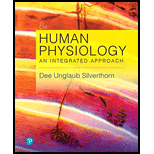
Concept explainers
a.
To define: The term “perfusion” and explain its significance in relation to cardiovascular physiology.
Introduction: Living organisms needs different systems that are properly functioning for a healthy living. Cardiovascular system is one such very important system that is required by living organisms. Defects in any part of the cardiovascular system can cause different types of disease.
b.
To define: The term “colloid osmotic pressure” and explain its significance in relation to cardiovascular physiology.
Introduction: Cardiovascular is one of the most important systems in humans. Comprised of heart, blood, and blood vessels, this system is important for transport of oxygen and other nutrients to all the cells in the body.
c.
To define: The term “vasoconstriction” and explain its significance in relation to cardiovascular physiology.
Introduction: Cardiovascular system is important for transport of different nutrients through the body. blood carries oxygen and other nutrients to different cells in the body. changes or improper functioning of any part of cardiovascular system causes different health issues.
d.
To define: The term “angiogenesis” and explain its significance in relation to cardiovascular physiology.
Introduction: Cardiovascular system comprises of solid functioning heart along with liquid connective tissue called blood. Hormones, oxygen and other important nutrients are transported to every cell of the body through the cardiovascular system.
e.
To define: The term “metarterioles” and explain its significance in relation to cardiovascular physiology.
Introduction: The cardiovascular system includes blood, blood vessels, and heart. the most important function of cardiovascular system is transportation of important gases such as oxygen and hormones along with nutrients throughout the body.
f.
To define: The term “pericytes” and explain its significance in relation to cardiovascular physiology.
Introduction:. Transportation of gases like oxygen and hormones is done by the cardiovascuklar system. The cardiovascular system is made up of the blood, blood vessels, and the heart. this system also collects waste material from all over the body and filters it in the kidneys.
Want to see the full answer?
Check out a sample textbook solution
Chapter 15 Solutions
EBK HUMAN PHYSIOLOGY
- What is behavioral adaptarrow_forward22. Which of the following mutant proteins is expected to have a dominant negative effect when over- expressed in normal cells? a. mutant PI3-kinase that lacks the SH2 domain but retains the kinase function b. mutant Grb2 protein that cannot bind to RTK c. mutant RTK that lacks the extracellular domain d. mutant PDK that has the PH domain but lost the kinase function e. all of the abovearrow_forwardWhat is the label ?arrow_forward
- Can you described the image? Can you explain the question as well their answer and how to get to an answer to an problem like this?arrow_forwardglg 112 mid unit assignment Identifying melting processesarrow_forwardGive only the mode of inheritance consistent with all three pedigrees and only two reasons that support this, nothing more, (it shouldn't take too long)arrow_forward
- Oarrow_forwardDescribe the principle of homeostasis.arrow_forwardExplain how the hormones of the glands listed below travel around the body to target organs and tissues : Pituitary gland Hypothalamus Thyroid Parathyroid Adrenal Pineal Pancreas(islets of langerhans) Gonads (testes and ovaries) Placentaarrow_forward
 Human Physiology: From Cells to Systems (MindTap ...BiologyISBN:9781285866932Author:Lauralee SherwoodPublisher:Cengage Learning
Human Physiology: From Cells to Systems (MindTap ...BiologyISBN:9781285866932Author:Lauralee SherwoodPublisher:Cengage Learning Medical Terminology for Health Professions, Spira...Health & NutritionISBN:9781305634350Author:Ann Ehrlich, Carol L. Schroeder, Laura Ehrlich, Katrina A. SchroederPublisher:Cengage Learning
Medical Terminology for Health Professions, Spira...Health & NutritionISBN:9781305634350Author:Ann Ehrlich, Carol L. Schroeder, Laura Ehrlich, Katrina A. SchroederPublisher:Cengage Learning Comprehensive Medical Assisting: Administrative a...NursingISBN:9781305964792Author:Wilburta Q. Lindh, Carol D. Tamparo, Barbara M. Dahl, Julie Morris, Cindy CorreaPublisher:Cengage Learning
Comprehensive Medical Assisting: Administrative a...NursingISBN:9781305964792Author:Wilburta Q. Lindh, Carol D. Tamparo, Barbara M. Dahl, Julie Morris, Cindy CorreaPublisher:Cengage Learning Human Biology (MindTap Course List)BiologyISBN:9781305112100Author:Cecie Starr, Beverly McMillanPublisher:Cengage LearningBasic Clinical Lab Competencies for Respiratory C...NursingISBN:9781285244662Author:WhitePublisher:Cengage
Human Biology (MindTap Course List)BiologyISBN:9781305112100Author:Cecie Starr, Beverly McMillanPublisher:Cengage LearningBasic Clinical Lab Competencies for Respiratory C...NursingISBN:9781285244662Author:WhitePublisher:Cengage





